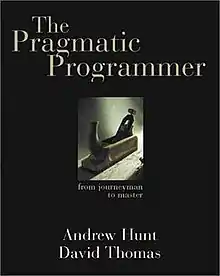The Pragmatic Programmer
The Pragmatic Programmer: From Journeyman to Master is a book about computer programming and software engineering, written by Andrew Hunt and David Thomas and published in October 1999.[1][2][3] It is used as a textbook in related university courses.[4] It was the first in a series of books under the label The Pragmatic Bookshelf. A second edition, The Pragmatic Programmer: Your Journey to Mastery was released in 2019 for the book's 20th anniversary, with major revisions and new material reflecting changes in the industry over the last twenty years.
 | |
| Authors |
|
|---|---|
| Country | United States |
| Subjects | Education, computer programming |
| Published | 1999 by Addison-Wesley |
| Pages | 320 |
| ISBN | 978-0135957059 |
| Website | pragprog |
The book does not present a systematic theory, but rather a collection of tips to improve the development process in a pragmatic way. The main qualities of what the authors refer to as a pragmatic programmer are being an early adopter, to have fast adaptation, inquisitiveness and critical thinking, realism, and being a jack-of-all-trades.[5]
The book uses analogies and short stories to present development methodologies and caveats, for example the broken windows theory, the story of the stone soup, or the boiling frog.[6] Some concepts were named or popularised in the book, such as DRY (or Don't Repeat Yourself) and rubber duck debugging, a method of debugging whose name is a reference to a story in the book.[7]
Publication history
References
- "8 Most Influential Books on Programming of All Time". 11 January 2016.
- "Top 40 Software Engineering Books".
- "12 Most Influential Books Every Software Engineer Needs to Read". 16 March 2015.
- "CSE 331 17sp Software Design & Implementation: Information and Syllabus".
- Hunt and Thomas, pp. xviii–xix.
- Hunt and Thomas, pp. 7-9.
- Pete Goodliffe (2014). Becoming a Better Programmer: A Handbook for People Who Care About Code. O'Reilly Media. p. 82. ISBN 978-1491905586.